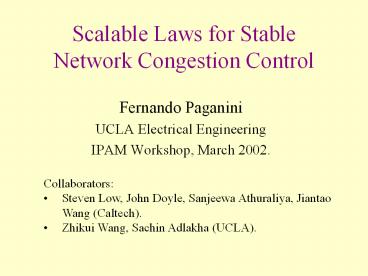Scalable Laws for Stable Network Congestion Control PowerPoint PPT Presentation
Title: Scalable Laws for Stable Network Congestion Control
1
Scalable Laws for Stable Network Congestion
Control
- Fernando Paganini
- UCLA Electrical Engineering
- IPAM Workshop, March 2002.
- Collaborators
- Steven Low, John Doyle, Sanjeewa Athuraliya,
Jiantao Wang (Caltech). - Zhikui Wang, Sachin Adlakha (UCLA).
2
Outline
- Introduction. Congestion control, models based on
prices. - Control objectives and linearized design. Local
stability theorem. - Global, nonlinear implementation. Alternatives to
improve fairness. - Packet level implementation in ns-2. Results.
- Conclusions.
3
Congestion Control Problem
End systems
Routers
Links
- Regulate transmission rates of end-to-end
connections so that they take advantage of the
available bandwidth, but avoid exceeding it
(congestion). - Motivation
- An interesting, large-scale feedback control
problem. - Deficiencies of current TCP (long queues,
oscillations). - Aim regulate large elephant flows to a stable
point that exploits available capacity, but keep
queues small so that uncontrolled mice can fly
through with minimal delay.
4
Fluid flow modeling
- L communication links shared by S
source-destination pairs.
Routing matrix
1
3
2
5
Congestion Control Loop
ROUTING
source rates
aggregate link flows
LINKS
SOURCES
link prices
aggregate prices
per source
Decentralized control at links and sources.
Routing assuming fixed, i.e. varying at much
slower time-scale.
6
Optimization interpretation
(Kelly et al, Low et al, Srikant et al.,)
7
Primal, dual, and the end-to-end principle.
Usual convention (Kelly, Maulloo, Tan 98)
primal dynamics at sources, dual dynamics
at links.
- It may appear that primal is closer to current
TCP, and the - end-to-end principle. However
- Current TCP has dynamics in both places.
- End-to-end principle is about complexity, not
dynamics.
8
Dynamics and the role of delay
- Without delay, nothing would stop us from
adapting the sources rates arbitrarily fast. - In the presence of delay, there is a stability
problem e.g., controlling temperature of your
shower. - Special case of general principle in feedback
systems what limits the performance (e.g. speed
of response) are characteristics of the open loop
(bandwidth, delay). - In this case, the only impediment is delay. In
particular, this sets the time-scale of our
response.
9
Congestion control loop with delays
Routing/ Delay matrix
SOURCES
LINKS
10
Control objectives and design
- Track available capacity, yet almost empty
queues. - Stability in the presence of large variations in
delay. - Dynamic performance respond as quickly as
possible. - Difficulties for control synthesis
- Large-scale, coupled dynamics but decentralized
information at links and sources. Decentralized
control design is hard. - Not just global variables, but the plant
(routing, capacities, ) changes in a way unknown
to sources/links. Must be robust. - Delay can vary widely. However, sources can adapt
to it. - To top it off, solution must be simple.
- Our approach
- Local linear design with classical heuristics.
- Validated analytically by a local multivariable
stability proof. - Global nonlinear laws built from the
linearization. - Performance verified empirically.
11
Matching capacity through integral control
12
Compensation for delay
13
Distributed gain compensation
SINGLE LINK
SOURCES
14
Nyquist argument for stability
15
Extension to arbitrary networks
Local analysis around equilibrium. Routing
matrices refer
here only to bottleneck links.
SOURCES
LINKS
p link prices
16
Stability result
17
Global, nonlinear implementation
Remark Athuraliya and Low 00 considered adding
another integrator to clear the queue. However,
scalable stability for arbitrary delays does not
extend to that case.
18
Global, nonlinear implementation
Static control law for sources linearization
requirement is
Elasticity of demand decreases with delay,
number of bottlenecks.
19
Properties of the nonlinear laws
- Global stability? Validate by
- Flow simulation of differential equations using
Matlab. So far, cases of local stability have
been global. - Mathematical proof. Tools which combine delay and
nonlinearity are very limited! We have partial
results for single link, but with further
parameter constraints. - Fairness of equilibrium?
- Difficult with exponential
- laws, which distinguish too
- sharply the rates for different
- delays.
20
An alternative with fairer allocation
- Back to linearization requirement
- More freedom in utility functions, but not
arbitrary.
21
Packet-level implementation
22
Packet-level implementation
- ns-2 implementation
- Modify REM-module for the links.
- Modify Vegas module for the sources.
23
Packet-level simulation in ns-2
60 sources starting in groups of 20, RTT120ms. 1
link, 25 pkts/ms
Queue
Window
Stable, but time-response not slower than
existing protocols.
24
Conclusions
- Classical design heuristics multivariable
analysis lead to a locally stable feedback
control under widely varying operating
conditions, and within very tight information
constraints. - From local to global extract nonlinear laws from
linearization conditions at every point. This
step leaves some degrees of freedom left for
addressing equilibrium fairness, etc. - Pending theory questions
- Global stability with nonlinearity and delay.
Partial results exist. - Equilibrium structure
- Packet implementation based on ECN marking
appears to perform well. In particular, fast
response, empty queues. - Issues for future studies
- Parameter settings some of them must be
universal. - Backward compatibility, incremental deployment.
25
Referenceshttp//www.ee.ucla.edu/paganini
- F. Paganini, J. Doyle and S.H.Low, Scalable Laws
for Stable Network Congestion Control ,
Proceedings IEEE Conference on Decision
Control, 2001. - S. H. Low, F. Paganini, J. Doyle, Internet
Congestion Control an Analytical Perspective,
IEEE Control Systems Magazine, Feb. 2002. - F.Paganini, S.H.Low, Z. Wang, S. Athuraliya, J.
Doyle, A new TCP congestion control with empty
queues and scalable stability, submitted to 2002
Sigcomm. - Z. Wang, F. Paganini Global Stability with Time
Delay in Network Congestion Control, submitted
to IEEE Conference on Decision Control, 2002.

